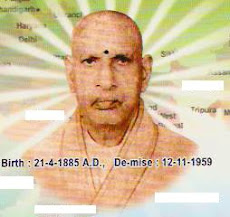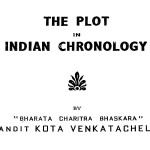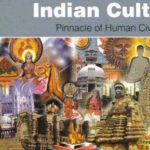
From the mists of legend to the waters of memory called history, it is a long process, and to some, may indeed appear to be a long leap. But let it be stated upfront that history is indeed history. Just as Science requires reproducibility and verifiability, so too does history require evidence and documented proof, and above all adherence to the truth.
 Pandit Kota Venkatachalam [2, 11]
Pandit Kota Venkatachalam [2, 11]
As we have demonstrated through this Series of Posts…
- An appeal to Young Indologists
- Aryan Invasion Theory Violates Vedic Tradition
- Who were the Yavanas?
- Personalities: Sagara
- Vedic Cosmology—The Dharmic View of Time
…Indian history has been subjected to much intellectual violence, and the case of evidence such as the Kumbhalgarh inscription, outright physical violence. Selective interpretation, foreign racial glorification, colonial expedience, document fabrication, and evidence forgery have been the tools of the trade of history’s most dishonest cabal of “historians”.
The most skilled propagandists are not those who claim obvious falsehoods, but rather, state selective and half truths. What is credible and plausible is often the most incorrigible…of falsehoods. Unlike the True Brahmanas of yore who preserved and passed on our Tradition and History, these Racist-Imperialists have no religious injunction to speak the truth (or to feel shame…). Indeed, contrary to their self-apotheosis and perennial self-lionising, the British were able to take control of India not through some Gandhian described physical or martial superiority, or even technological marvelry, but rather, through deception.
As the Oxford Military History of the World would credit, it was British mastery of subcontinental politics (a.k.a. deception and back-stabbing) that ensured their control of 200 hundred million souls. It is also an abject lesson of what happens when you only consider “Rajniti” rather than Niti and Dharma. This parampara of foreign ‘intellectuals’ committed intellectual violence against our texts, tradition, and history. Their tradition continues today in its “post-modern” incarnation, wherein even the Ramayana date from the Colonial era has been brought down from BCE to CE, all by the supposedly secular poco-pomo gang. Even Chanakya-Kautilya has not been spared, and is now being denied, not on the basis of new evidence, but on the basis of new “interpretations” of evidence and ostensible tampering of evidence. Enough benefits of the doubt.
This is why Indian history, Indian culture, and Indian civilization must be logically and truthfully re-constructed from Indians, by Indians, and for Indians…real Indians rooted in the land and its tradition and culture. Others tamper with it in the name of expedience (previously British Empire, now Breaking India), real Indians tell it in the name of the truth. Therefore, if the colonial history we have been taught is not simply in need of correction, but root-and-branch re-construction, it becomes imperative to start at the beginning.

Students of history would already be familiar with that much bally-hooed “Sheet-anchor of History” (as so named by Max Muller and concocted by William Jones, et al) based Alexander’s Invasion of India in 326 B.C., and Chandra-gupta Maurya’s coronation at Pataliputra in 321 B.C.E. However, as seen, and as soon will be seen, Pandit Kota Venkatachalam, through painstaking and disciplined historical research—rather than the navel-gazing our gyaanis are notorious for—demonstrated why the former was an unimportant event and the latter, an utter falsehood. If the wrong Chandra-Gupta were purposefully identified as the ruler of Magadha in 321 B.C.E (It was actually Chandra Gupta I), then what in fact is our true benchmark for asserting verifiable and recorded “history” from mere legend?

Furthermore, acceptance and assertion of this position as genuine History, is supported by our own independent study of history over decades. Many of the charges and allegations originally made by Pandit Chelam, were independently observed by us in a number of different topics under Indian history, routinely and repeatedly. Only, we do not claim the authority of an Acharya, which Pandit Chelam is most deserving of and eminently qualified as. The sole purpose of this point is to note that 3138 B.C.E was not cavalierly arrived at, nor do we treat Pandit Chelam’s word as the “gospel” (pardon the expression). The Itihaas of the Mahabharata is not merely the legend from an epic, but the Chronologically concrete Historical Past of the Indian Subcontinent & the true Sheet anchor of its History.

It was Sri Venkatachalam’s own exemplification of historical methodology, logical investigation, scholarly subject-matter-expertise, but above all, scrupulous adherence to the Truth throughout his publications on History, that established the credibility of this dating. It was only after properly surveying his original reference sources that we have put our weight behind this, and recognise not only the possibility or plausibility, but also the near-certainty that this is in fact the correct Sheet Anchor for Indian History. Those who wish to contest this claim on whatever grounds, are advised to refer to not only our previous articles listed above, which establish the credibility of this historical foundation, but Pandit Chelam’s own large selection of works in English.
The next natural objection, of course, is whether Mahabharata Epic, which features not only weaponry beyond scientific verification (Divine missiles called astras), but also the supernatural or paranormal (Divine Beings, Incarnations of God, and even Demons) could be treated as History? The answer, of course, is that if both Homer and Herodotus (“Father of History” for Europeans), who both feature the Sun God and other divine beings (even a Cyclops), as part of their works can be considered “Sources of Authentic History”, then there is no reason the Mahabharata cannot be. Vyasa’s Epic may feature “mythological” aspects that are not believable in our own time, but if Homer and Herodotus’ Divine involvement in historical events can be explained away as “allegory/metaphor ” or “poetic license”, then there is no reason this same standard cannot be applied to the Mahabharata. Let these non-scientifically verifiable aspects be treated as allegory or atisayokti by our atheist friends, but let the basic sequence of events be treated as History: Dynasty, Succession Crisis, Subcontinetal War, Coronation.
And as for the age of many of the characters (between 120-200 years), well if Methusaleh (Grandsire of Noah) at ( 969 years) could have been accepted by William Jones’ and his Christian Chronology, which serves as the basis for the present “Post-Modern” Chronology, can be glossed over, then so can this.
When a real history by a real historian such as Kalhana can accept the historicity of the Kurukshetra War, than there is no reason we lesser mortals cannot.
 The Time has come to reclaim our True History of Bharatavarsha. Let there be no more confusion!
The Time has come to reclaim our True History of Bharatavarsha. Let there be no more confusion!
Here is what Bharata Charitra Bhaskara, Pandit Sri Kota Venkatachalam wrote on the matter [Emphasis and Proofing ours].
 Pandit Kota Venkatachalam [3, 39]
Pandit Kota Venkatachalam [3, 39]
The following Post was originally published at True Indian History on June 26, 2009

The following Post was originally published at True Indian History on June 27, 2009

The following Post was originally published at True Indian History on June 28, 2009


The following Post was originally published at True Indian History on August 16, 2009
Gift Deed of Janamejaya — An Early Inscription of Kali Era
According to the Mahabharata (2nd Aswasa of Adiparva) Parikshit ruled for 60 years from the first year of the Kali (3101 B. C.) Era and died stricken by the curse of a Rishi(3041 B. C), when the coronation of Janamejaya his son, took place in Kali 61,(3041 B. C.).
An inscription (plate) of a gift deed by Emperor Janemejaya. (Indian Antiquary P. P. 333-334) runs thus:-
 This is the first inscription known which used the Jayabhyudaya Yudhistira Saka, which had its origin in Kali first year; (Both the Eras started in the same cycle year Pramadhi. This gift deed refers to a gift of land for the worship of Sri Sita and Rama on the bank of the Thungabhadra River, by Janamejaya (son of Parikshit) in the 89th year of Jayabhyudaya Yudhistira Saka i. e. Kali 89 i. e. B. C. 3012. The year Plavanga mentioned in the inscription tallies with the 89th year of Kali. Kali Era starts in the year 3102 B. C., the 20th Feb. at 2-27’-30″ hours. i.e. in the cycle year of Pramadhi the 1st day of the bright half of the month of Chaitram at 2-27-30 hours. Similar gift by the same Emperor Janamejaya was made on the same day to Sri Goswamy Anandalinga Jangama of Ushamutt through his disciple Jnanalinga Jangama for the worship of God Kedaranath in Kedara Kshetra situated in north Himalaya. The Inscription (plate) of the above gift which is preserved in the mutt even to this day runs thus:
This is the first inscription known which used the Jayabhyudaya Yudhistira Saka, which had its origin in Kali first year; (Both the Eras started in the same cycle year Pramadhi. This gift deed refers to a gift of land for the worship of Sri Sita and Rama on the bank of the Thungabhadra River, by Janamejaya (son of Parikshit) in the 89th year of Jayabhyudaya Yudhistira Saka i. e. Kali 89 i. e. B. C. 3012. The year Plavanga mentioned in the inscription tallies with the 89th year of Kali. Kali Era starts in the year 3102 B. C., the 20th Feb. at 2-27’-30″ hours. i.e. in the cycle year of Pramadhi the 1st day of the bright half of the month of Chaitram at 2-27-30 hours. Similar gift by the same Emperor Janamejaya was made on the same day to Sri Goswamy Anandalinga Jangama of Ushamutt through his disciple Jnanalinga Jangama for the worship of God Kedaranath in Kedara Kshetra situated in north Himalaya. The Inscription (plate) of the above gift which is preserved in the mutt even to this day runs thus:
 ……and so on.
……and so on.
In those times sacrifices were much in vogue and the Aswamedha and Sarpayaga performed by Janamejaya have become famous. Satanika, the eldest of the five sons of Janamejaya succeeded him to the throne. In his time in Naimisaranya the Satrayaga was performed by Saunaka and other Rishis, which is supposed to take one thousand years. The kings of this dynasty ruled till Kali 1468 (or 1634 B.C.), and in their time the Vedic religion was patronised and protected. In the several Yagnas performed in those days many animals were sacrificed and the common men were disgusted with the sacrifices of animals. Then in Kali 1215 or 1887 B.C. Buddha was born, to Suddhodana, the 23rd king of the Ikshvaku Royal dynasty of Kosala and preached a new religion in opposition to and in disregard of the Vedas.

There is no prominent event in the history of the Ikshvaku Royal dynasty except for the birth of Buddha in 1887 B.C. In Kali 1468(B.C. 1634) Kshemaka, the last Emperor of the royal dynasty of Hastinapura and Sumitra, the last king of the royal Ikshvaku dynasty of Kosala Kingdom both died childless. So the king of Magadha became Emperor and founder of the Imperial dynasty of Magadha.(Capital of Magadha was ‘Girivraja’)
The following Post was originally published at True Indian History on July 1, 2009

Pandit Kota Venkata Chelam wrote:
As researches progress this date (1887-1807 B. C.) of Buddha is bound to be accepted by scholars, if the scholars have not so far arrived at this date, it was because there was a common notion among them that the last word on the subject had been already said. If they had realised that the question was open for further investigation atleast some of them would certainly pursue enquiry in this direction and arrived at the date fixed by me.
It is highly refreshing to note that there is at least one scholar who could not superstitiously believe the existing theory about Buddha’s date, but thought it worthwhile to investigate into the question with an open mind. I refer to Sri V. Thiruvenkatachariyar M.A., L.T., (Formerly Head of Department of Mathematics, Govt. Arts College., Rajahmundry.) who arrived at the same date as myself (1807 B. C.) as the year of Buddha’s death and has fixed the actual day of the week and the month also. (Tuesday, Vaishakha Purnima).
His way of approach to the subject was astronomical. The fact that the same date 1807 B. C. was arrived at by two different ways of approach may induce the scholars to pause and try to revise the existing fictitious date of Buddha Nirvana. (483 B. C.). Having arrived at the same date independently we had occasion to compare notes at a stage when the present volume(1) was completely printed and was awaiting binding. I thought it worthwhile to incorporate the learned professor’s thesis in this volume. He has kindly permitted this and has sent a typed copy of his thesis, (on 18-1-55) which is herein incorporated. I am thankful to the professor for thus helping the cause of the true historical research which both of us have at heart.
(1) Age of Buddha,Milinda & Amtiyoka and Yuga-Purana by Pandit Kota Venkata Chelam (1956)
 Pandit Kota Venkatachalam [3, 29]
Pandit Kota Venkatachalam [3, 29]
All this makes Rajiv Malhotra’s Battle for Sanskrit so relevant for our times. For if foreigners claim a monopoly not only on interpretation of our traditional texts (we have seen how self-serving and expedient they have been with shifting dates to serve changing needs), but on even training future scholars of Sanskrit in foreign universities, who will be left who understands the real value of our text and tradition?
Apropos for the times, a Sanskritist almost a century ago made the same complaint about foreign malfeasance with our texts for the purpose of their political expedience.
 Jatavallabula Purushottam. Sanskrit Lecturer S.R.R., and C.V.R College Vijayawada (Andhra Pradesh) [3, xvii]
Jatavallabula Purushottam. Sanskrit Lecturer S.R.R., and C.V.R College Vijayawada (Andhra Pradesh) [3, xvii]
Many of you may ask “Have they no shame?”, but the question is, don’t we? The same social media whiners who carp and cavil about kings of yore failing to do the right thing, are now doing the same. Some have sold out, others are too scared, but some are simply spoiled, rotten brats who have no integrity to do the right thing and come together for a common cause. Unjustifiably arrogant, they, as Pandit Chelam complained of Rai Bahadurs past, simply hold on to the history they have been taught because it is comfortable and convenient for them. They are no different than the petty princelings who complained to Yashwant Holkar about what could have been…He replied contemptuously noting there was no point day-dreaming now. If only they had done their duty, their little part, when they had the chance…
It is not enough to merely claim the mantle of “Science and Reason”, but to actually test these “scientific” claims against empirical analysis and logic. The history we have been taught is wrong. Time to set it right. Not in the name of ego. Not in the name of self-glorification. But in the name of the truth…the real Truth.
Satyameva Jayate

References:
- True Indian History. [Various Blog Bosts]
- Kota, Venkatachalam Paakayaji (Pandit). The Mahabharata War. Vijayawada: Tirumala.1988 (posthumously)
- Kota, Venkatachalam Paakayaji (Pandit). The Plot in Indian Chronology.Vijayawada: Arya Vijnana. 1953
- Kota, Venkatachalam Paakayaji (Pandit). Chronology of Ancient Hindu History Part I. Vijayawada:AVG
- Kota, Venkatachalam Paakayaji (Pandit). The Age of Buddha, Milinda, and Amtiyoko. Guntur: Sri Ajanta Printers.1956
Acknowledgment: Our sincere thanks to Sri G.D. Prasad garu, grandson of Pandit Kota Venkatachalam for his kind permission to reprint these articles and excerpts.



